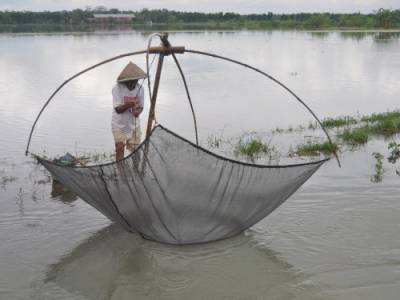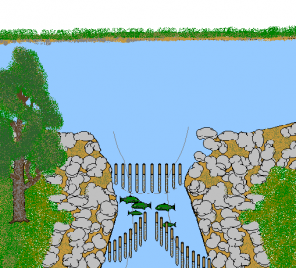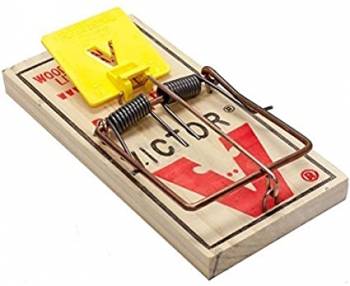Click for SiteMap
Table of Contents
Ultralight Hunting
Having a teacher is of great benefit, so if you have access to someone, indenture yourself if you have to. I have practically no experience. This article will be about what little I know, and what I look up.
Goal Parameters: (there's a better word for this)
- Be discreet. For example, the weapon should fold, or takedown, and fit inside the backpack or strapped to it.
- Select the method more likely to result in success, in the least amount of time. The goal is to be able to feed yourself. Also to not get discouraged.
- Choose small prey. You don't want to take on long term food storage. Kill what you can eat in a few days. Rabbits are a good size, and even a squirrel is a meal.
Ballistics Equipment
| Weapon | Pros | Cons |
|---|---|---|
| Slingshot | Unlimited ammo. Very simple and compact. | You may injure the critter, where it gets away but dies slowly. |
| Blow Gun | Very Simple, but what about accuracy? | Very long, unwieldy tube required for speed and accuracy? Limited range? |
| Slingshot Bow | Very simple and compact. | Not as accurate as regular bow, even when the slingshot has a wrist brace. Although I'd like to try again by having non-takedown arrows and using my wrist to apply pressure to the wrist brace while firing. |
| Takedown Arrows | Regular arrows are too long and aren't practical being carried along dense trails. | In order to fly straight, An arrow should be uniform along the length. Takedown arrows have very poor accuracy. |
| Takedown Bow | I love archery | Shooting with a bow requires skill, and I have no experience in shooting moving targets or estimating flight path over distance. |
| Compound Bow | Better performance than regular bow. Really gorgeous. | Too bulky. Also heavier than regular bow. Although some more expensive bows weigh only 3 lbs despite high strenght pull. There's no such thing as a takedown compound bow. |
| Crossbow | More accurate than a slingshot. More accurate than a bow because it reduces the imperfection of human movements. | 1) Less accurate over longer distances, in part because of lesser kinetic energy of shorter arrows. 2) Crossbows are really heavy for some reason: “Crossbows are heavy, even those that start off at a mere 5.9 to 6.9 lbs, once they are outfitted with a scope, rings, sling, quiver, arrows and miscellaneous…” source Some weaker, lighter ones start at 4-5 lbs, but they will have less accuracy due to the slower arrow. 3) Crossbows are almost as bulky as compound bows. There are a few low-powered takedown crossbows, which make them stowable. Some very expensive compound crossbows that are $1000 and up are made narrow and thus better stowable. Even more so if the gunstock were detachable (or extendible) to reduce the overall length. |
| Air Gun | Accurate. | Loud compared to archery or darts, although less so than a regular gun, and a silencer can be used to further reduce the blast. “Another nice benefit to owning a good survival air rifle is that you can purchase them online with zero restrictions. They are not regulated by our nanny government so you can buy as many as you want today with no hassles.” skilledsurvival.com |
| Pipe Gun | Does not look like a gun. Doesn't weigh much or take up a lot of space. | Very Loud. Firearm regulations. Regular ammunition with gunpowder. |
Bear Archery Cruzer G2 Adult Compound Bow 3 pounds
Escape SS by AirForce Airguns 4 pounds
Pack Rifle 500g (1 pound)
Trapping
If you are backpacking with your cat, this is not an option.
The lightest weight traps are those you make with rope, tree branches and rocks. I found a good tutorial online that I will learn from:
https://www.outdoorlife.com/how-build-trap-15-best-survival-traps
Another light option are snares:
The smallest professional trap in USA is the DUKE 110 BODY GRIP TRAP. It measures 114mm x 114mm and is pretty heavy. You are unlikely to find an ultralight titanium version. Even though it is the smallest version from Duke, this trap is tough to spread and dangerous to handle.
You can find traps that weigh less on ebay or aliexpress. The springs are not as strong as on the Duke trap.
The lightest body trap option is the Victor M326 Rat Trap. You can increase the strength of the trap by placing a spacer between the spring ends and the wood (the two ends in the middle of the trap), as seen in this article. They are incredibly effective near shelters along the Appalachian Trail. Bon appetit!
Further reading: https://grandpappy.org/wsnares.htm
Fishing
Wikipedia covers different fishing techniques:
https://en.wikipedia.org/wiki/Fishing_techniques
Hand gathering: Depending on location, there are shellfish and crabs that are easy to gather. Salt helps catch razor clams You can hold a crab by the armpits.
Spear fishing: If you can see through the water, a spear can be used, such as your trekking pole.
Pole fishing
An ultralight and compact fishing pole would be a carbon fiber pole and mini reel. A 1.5 meter telescoping pole compacts to a length that fits even in a day pack. Pole fishing can be fruitful, but it is more of a sport. To have a better chance of success, you can use longlining, nets, and/or traps.
You can attract fish to the bait with a dough ball that disassembles under the water next to your bait. See this video by fishin n stuff.
Another alternative by Ari Davies, is to heat and mix 50% lard, 25% paraffin (candle) wax, and 25% meat with blood. Make sure to use a double boiler. Once cool it will stay on your hook sufficiently.
There are also scents or menhaden oil you can buy that you can apply to your lures, or even to a cotton ball.
For saltwater, the scent of the natural prey is the best strategy to attract predator fish. A common natural prey is shrimp.
Longlining
Longlining involves running a heavy fishing line between two visible bobs such as empty plastic bottles. From the heavy line running along the surface, you run individual lines (snoods), each having a bob at the top and a weight and baited hook at the bottom. You leave this unattended at a lake. If at a stream or river you would have to secure the ends or secure one end from the middle of the stream.
This can be difficult to set up without a boat. However, you can swim out with the heavy line and two bobs, and a bag with the snoods inside. Each snood has its own bag within the main bag to avoid tangling. The snoods have a clip to attach to the main line.
Nets
A small gillnet or driftnet may be the most compact UL net option for catching fish. It catches fish when they unknowingly swim into it. If the fish is the right size, it will be too big to swim through, but have its gills or fins get caught in the net. The floats can be bladder-bottles or dry-bags, and the weights can be stones.
You can throw some bread crumbs to attract fish to the area. If you gut the fish to eat, use the guts as a lure to attract more fish if desired. For saltwater fish, you can make chum with a mixture of tropical/saltwater fish food, menhaden oil and water. Another fellow added menhaden oil to a sponge inside a jar with perforated lid and a weight to sink it to the bottom, although a scent product that isn't oil based may work better.
“For the average fish, the most efficient mesh size is between 1 1/2 inches to 1 5/8 inches (3.8 cm to 4.1 cm). This size mesh will catch the maximum number of fish of average edible size, plus a reasonable number of larger fish. It will also catch more total pounds of edible fish each day.” Further reading at grandpappy.org
“Gillnets are a pain to deploy and use, so I normally just shape some of the netting into weirs, deployed with the shoreline forming one “wing” of the weir. Bait the weirs with guts/heads of previous catches (once you make some) and also create and use a seine. The seine is used to push fish towards the weirs. So I use mesh that's small enough (ie, 1.5” mesh) to catch any fish worth eating. Gillnets rarely catch anything but the size of fish it's designed to catch, so it's very limiting. If the fish is too big, the netting just turns it away, unless it gets wrapped up or caught by the snout, in some cases. If you make the mesh big enough to catch decent-sized fish (ie, 3“ or larger) then a lot of small fish will not be caught.” wasach at bushcraft forum


A lift net sits at the bottom of shallow water, while some food lures fish to swim above the net. Lift nets can be folded into a long slender piece.

Traps
Weirs
If the water isn't very deep, you can make a trap from whatever is in the area, either sticks or stones. See fishing weir.


Bait Traps
You can use a coke bottle by cutting the top section and turning it in on itself. Place anything for bait in the bottle and secure under a rock to catch shrimp/prawns. See video, which also explains how to secure and orient a gill net to avoid sea currents.






Discussion